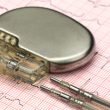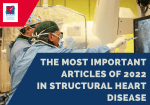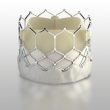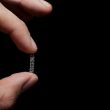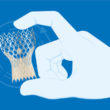Transcatheter aortic valve replacement (TAVR) in low-risk patients has been shown to be superior or noninferior in randomized studies, but the presence of valvular thrombosis, in its different forms, has not been well analyzed, nor is there much information on its impact on evolution. Researchers conducted an analysis of the LTR study that included 200<a href="https://solaci.org/en/2023/06/07/tavr-does-halt-affect-follow-up/" title="Read more" >...</a>
EuroPCR 2023 | ACURATE Neo2: Results After 5 Years
The ACURATE Neo2 valve is an evolution of the first-generation ACURATE Neo valve with a low rate of pacemaker implantation and a decrease in paravalvular leak, also compatible with the 14F introducer. This prospective study included patients with symptomatic severe aortic stenosis at high surgical risk who underwent ACURATE Neo2 valve implantation. The primary endpoint<a href="https://solaci.org/en/2023/05/23/europcr-2023-acurate-neo2-results-after-5-years/" title="Read more" >...</a>
EuroPCR 2023 |TAVR in Cardiogenic Shock
Patients presenting aortic stenosis with cardiogenic shock are at extreme risk, with 70% mortality until the aortic obstruction is resolved, and taking into account they make poor transplant candidates. Safety and efficacy of TAVR in patients with cardiogenic shock remains unclear. The aim of this study was to assess events in patients undergoing TAVR with<a href="https://solaci.org/en/2023/05/17/europcr-2023-tavr-in-cardiogenic-shock/" title="Read more" >...</a>
Is There a Way to Reduce the Need for Permanent Pacemaker Implantation in Self-Expanding Valves?
We are well aware of the benefits of TAVR in different scenarios, but the need for permanent pacemaker implantation (PPI) in self-expandable valves is between 15% and 30% according to different randomized and non-randomized studies. This is why the higher implantation strategy or cusp overlap (COT) was developed and, though it has been shown to<a href="https://solaci.org/en/2023/04/20/is-there-a-way-to-reduce-the-need-for-permanent-pacemaker-implantation-in-self-expanding-valves/" title="Read more" >...</a>
Clinical Impact of Coronary Artery Disease on Results After TAVR
Coronary artery disease (CAD) coexists with aortic stenosis in about half the patients who suffer the latter. These patients receiving antiplatelet therapy are at a higher risk of periprocedural bleeding—one of the most frequent complications in patients who undergo transcatheter aortic valve replacement (TAVR). One way of limiting the risk for bleeding is choosing the<a href="https://solaci.org/en/2023/04/17/clinical-impact-of-coronary-artery-disease-on-results-after-tavr/" title="Read more" >...</a>
The Most Important Articles of 2022 in Structural Heart Disease
Discover the most read scientific articles on interventional cardiology of 2022 in our website. We Should Treat Significant Stable CAD in Patients Undergoing TAVR Aortic stenosis is associated to significant coronary artery disease (CAD) in nearly 50% of cases. When we decide to treat aortic disease using surgery, it has been established we should also treat<a href="https://solaci.org/en/2023/01/12/the-most-important-articles-of-2022-in-structural-heart-disease/" title="Read more" >...</a>
Real-World Results of Different Devices for TAVR
Transcatheter aortic valve replacement (TAVR) keeps growing in terms of the development of new devices, more extensive operator experience, and enhanced procedure planning. Nowadays, there are multiple device options, which depend on patient characteristics and operator experience. Two-arm studies compared these devices, analyzing the potential benefits of a certain valve over the others. This multicenter<a href="https://solaci.org/en/2023/01/04/real-world-results-of-different-devices-for-tavr/" title="Read more" >...</a>
We Should Treat Significant Stable CAD in Patients Undergoing TAVR
Aortic stenosis is associated to significant coronary artery disease (CAD) in nearly 50% of cases. When we decide to treat aortic disease using surgery, it has been established we should also treat heart disease. However, when using transcatheter aortic valve replacement (TAVR), this is still unclear, given that in many occasions we see stable lesions<a href="https://solaci.org/en/2022/12/30/we-should-treat-significant-stable-cad-in-patients-undergoing-tavr/" title="Read more" >...</a>
Is There any Difference between Modern Valves and Self and Balloon Expandable Valves?
At present TAVR is a valid alternative to treat different risk groups of patients with severe aortic stenosis. Among the different valves, there are two types, the self-expanding (SEV) and the balloon expandable (BEV) valves, that are the most implanted and the most researched by randomized studies across different risk groups. There are different generations<a href="https://solaci.org/en/2022/12/16/is-there-any-difference-between-modern-valves-and-self-and-balloon-expandable-valves/" title="Read more" >...</a>
SURTAVI at 5 Years
Transcatheter aortic valve replacement (TAVR) by transfemoral access has shown great benefit for different risk groups, but its long-term durability is still uncertain. Available evidence comes from small analysis and a single randomized trial with 280 patients and an 8 year follow-up: the NOTION Trial, where TAVR showed less valvular degeneration than aortic valve replacement (AVR) surgery.<a href="https://solaci.org/en/2022/10/17/surtavi-at-5-years/" title="Read more" >...</a>


